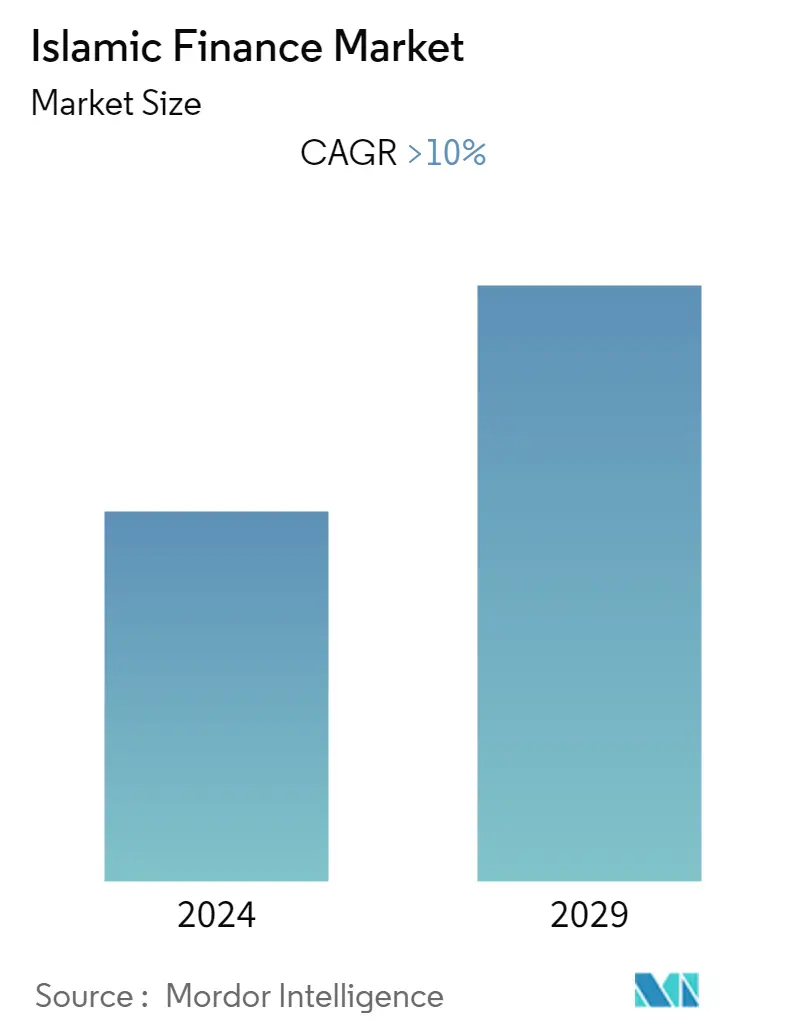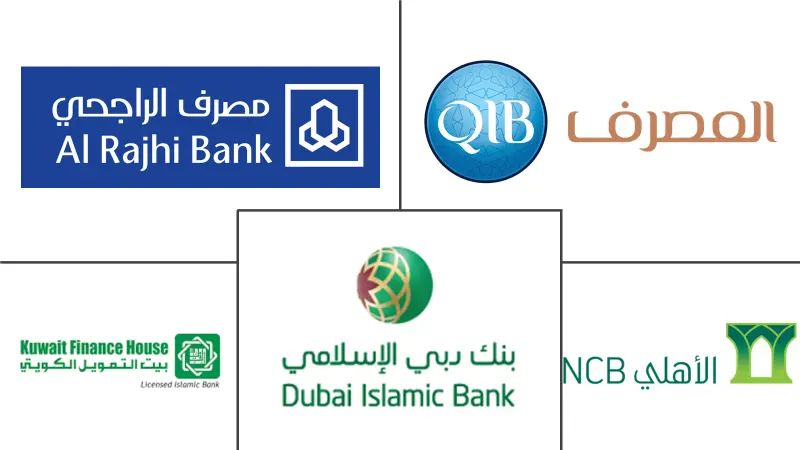Market Size of Islamic Finance Industry

| Study Period | 2020 - 2029 |
| Base Year For Estimation | 2023 |
| CAGR (2024 - 2029) | 10.00 % |
| Fastest Growing Market | Asia Pacific |
| Largest Market | Middle East and Africa |
| Market Concentration | Low |
Major Players
*Disclaimer: Major Players sorted in no particular order |
Islamic Financial Market Analysis
The Islamic Finance Market is expected to register a CAGR of greater than 10% during the forecast period(2024-2029).
In 2021, the total net income reported by Islamic financial institutions around the world went from USD 10.5 billion in 2020 to USD 32 billion. This shows that things are getting better, especially for Islamic banks.
The Islamic finance industry had another tough year, with many markets slowly getting back up to speed and countries reopening their economies. But new waves of the COVID-19 virus, first the Delta variant and then the Omicron variant, stopped the progress. The new COVID-19 waves caused new lockdowns or safety measures, which again messed up global supply chains and made it more expensive to move things. The year 2021 ended on a better note because most countries were able to loosen their pandemic-related rules because they had high vaccination rates. Because of this, the world's demand for oil went up faster than it could be made, since OPEC+ production limits were locked in by an agreement signed in late 2020. Consequently, crude oil prices increased in 2021, with the spot prices of Brent and West Texas Intermediate (WTI) crude oil closing the year at USD 77.78 and USD 75.21, respectively, up from USD 51.09 and USD 47.62 at the start of January. This eased budgetary pressures on the GCC economies that depend on oil revenues.
Islamic Financial Industry Segmentation
Islamic finance started 50 years ago in countries with many Muslims who wanted to ensure that their money sources followed Shariah and other Islamic principles. Islamic Banking, Islamic Insurance (Takaful), Other Islamic Financial Institutions (OIFLs), Islamic Bonds (Sukuk), and Islamic Funds are all different parts of the global Islamic finance market. By geographic region, the Islamic Finance market can be segmented into the Gulf Cooperation Council (Saudi Arabia, Kuwait, UAE, Qatar, Bahrain, and Oman), the Middle East and North Africa (Iran, Egypt, and the Rest of MENA), South Asia and Asia-Pacific (Malaysia, Indonesia, Brunei, Pakistan, and the Rest of South Asia and Asia-Pacific), Europe (the United Kingdom, Ireland, Italy, and the Rest of Europe), and the Rest of the World. The report also gives a complete background analysis of the global Islamic finance market, including analysis and forecast of market size, market segments, industry trends, and growth drivers. The report offers market size and forecasts for the Islamic Finance Market in value (USD) for all the above segments.
| By Financial Sector | |
| Islamic Banking | |
| Islamic Insurance : Takaful | |
| Islamic Bonds 'Sukuk' | |
| Other Islamic Financial Institution (OIFI's) | |
| Islamic Funds |
| By Geography | ||||||||
| ||||||||
| ||||||||
| ||||||||
| ||||||||
| Rest of the World |
Islamic Finance Market Size Summary
The Islamic finance market is poised for significant growth, driven by a robust compound annual growth rate over the forecast period. Despite challenges posed by the COVID-19 pandemic, which disrupted global supply chains and impacted economic activities, the industry has shown resilience. The recovery in oil prices, particularly benefiting GCC economies, has provided a favorable backdrop for the sector's expansion. Malaysia stands out as a key player in the Islamic finance landscape, with a well-established regulatory framework that supports the growth of Shariah-compliant financial institutions and instruments. The country's proactive initiatives and educational investments have positioned it as a global hub for sukuk issuance, attracting international issuers and investors to its vibrant Islamic capital market.
The Islamic finance market is characterized by fragmentation, with numerous players vying for market share in developing regions like Asia and Africa, while the GCC remains highly competitive with significant international presence. The takaful sector, although smaller, is experiencing double-digit growth and undergoing consolidation to enhance competitiveness. Mergers and acquisitions, such as those involving Dar Al Takaful and Watania in the UAE, are aimed at reducing costs and strengthening market positions. Major players in the GCC, including Bank Al-Rajhi and Dubai Islamic Bank, continue to shape the competitive landscape. Recent strategic moves, such as Abu Dhabi Islamic Bank's increased ownership in ADIB Egypt and Kuwait Finance House's acquisition of Ahli United Bank, highlight ongoing consolidation and expansion efforts within the industry.
Islamic Finance Market Size - Table of Contents
-
1. MARKET INSIGHTS AND DYNAMICS
-
1.1 Market Overview
-
1.1.1 Insights on Top Islamic Finance Development Indicator (IFDI) Market
-
1.1.2 Insights on Countries with Highest Islamic Finance Assets
-
1.1.3 Insights on Countries with Highest Islamic Banking Assets
-
1.1.4 Insights on Islamic Insurance Growth
-
1.1.5 Insights on Regulatory Requirement of Islamic Finance
-
-
1.2 Market Drivers
-
1.3 Market Restraints
-
1.4 Porter's Five Forces Analysis
-
1.4.1 Bargaining Power of Buyers/Consumers
-
1.4.2 Bargaining Power of Suppliers
-
1.4.3 Threat of New Entrants
-
1.4.4 Threat of Substitute Products
-
1.4.5 Intensity of Competitive Rivalry
-
-
1.5 Impact of COVID-19 on the Market
-
-
2. MARKET SEGMENTATION
-
2.1 By Financial Sector
-
2.1.1 Islamic Banking
-
2.1.2 Islamic Insurance : Takaful
-
2.1.3 Islamic Bonds 'Sukuk'
-
2.1.4 Other Islamic Financial Institution (OIFI's)
-
2.1.5 Islamic Funds
-
-
2.2 By Geography
-
2.2.1 GCC
-
2.2.1.1 Saudi Arabia
-
2.2.1.2 UAE
-
2.2.1.3 Qatar
-
2.2.1.4 Kuwait
-
2.2.1.5 Bahrain
-
2.2.1.6 Oman
-
-
2.2.2 MENA
-
2.2.2.1 Iran
-
2.2.2.2 Egypt
-
2.2.2.3 Rest of Middle East & North Africa
-
-
2.2.3 Southeast Asia & Asia-Pacific
-
2.2.3.1 Malaysia
-
2.2.3.2 Indonesia
-
2.2.3.3 Brunei
-
2.2.3.4 Pakistan
-
2.2.3.5 Rest of Southeast Asia and Asia-Pacific
-
-
2.2.4 Europe
-
2.2.4.1 United Kingdom
-
2.2.4.2 Ieland
-
2.2.4.3 Italy
-
2.2.4.4 Rest of Europe
-
-
2.2.5 Rest of the World
-
-
Islamic Finance Market Size FAQs
What is the current Islamic Finance Market size?
The Islamic Finance Market is projected to register a CAGR of greater than 10% during the forecast period (2024-2029)
Who are the key players in Islamic Finance Market?
Bank Al-Rajhi , Dubai Islamic Bank, Kuwait Finance House, Qatar Islamic Bank and National Commercial Bank Saudi Arabia are the major companies operating in the Islamic Finance Market.

